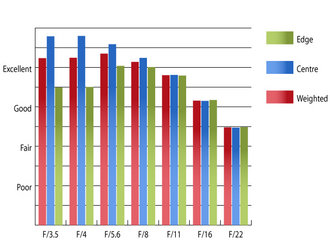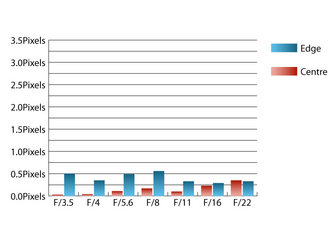Panasonic Lumix G 8mm f/3.5 Fisheye Lens Review
Panasonic Lumix G Fisheye 8mm f/3.5 Performance
Sharpness in the centre of the frame is outstanding from maximum aperture, with the quality towards the edges starting off very good here. Stopping the lens down a little improves the quality from edge to edge, with peak sharpness across the frame occurring at f/5.6. Beyond this aperture, resolution is reduced due t diffraction, although the lens still performs well down to f/16. | How to read our chartsThe blue column represents readings from the centre of the picture frame at the various apertures and the green is from the edges. Averaging them out gives the red weighted column. The scale on the left side is an indication of actual image resolution. The taller the column, the better the lens performance. Simple. For this review, the lens was tested on a Panasonic Lumix G3 using Imatest. |
Chromatic aberrations often figure strongly with fisheye optics, but not in the case of this lens. At their strongest, chromatic aberrations just exceed half a pixel width towards the edges of the frame at f/8, which will be difficult to spot, even in large prints or harsh crops from near the edges of the frame.
 | How to read our chartsChromatic aberration is the lens' inability to focus on the sensor or film all colours of visible light at the same point. Severe chromatic aberration gives a noticeable fringing or a halo effect around sharp edges within the picture. It can be cured in software. Apochromatic lenses have special lens elements (aspheric, extra-low dispersion etc) to minimize the problem, hence they usually cost more. For this review, the lens was tested on a Panasonic Lumix G3 using Imatest. |
It is very difficult to measure falloff towards the corners of the frame with this lens due to the extremely wide field of view. In practice I only noticed a small amount of falloff towards the corners at f/3.5 with visually uniform illumination being achieved from f/4 onwards.
In certain conditions, this lens can be quite prone to flare, especially if a strong point source of light, such as the sun, is in the frame towards the edges. It does take quite harsh conditions to cause flare in images, and so it is not an issue much of the time.
Add your message
Login required
Please login here or if you've not registered, you can register here. Registering is safe, quick and free.
Please login here or if you've not registered, you can register here. Registering is safe, quick and free.
photodo Stats
1102 lenses
428 MTF tests
74 in-depth photodo reviews
100+ users join each day
Help the lens community by reviewing or rating a lens today via our lens search
428 MTF tests
74 in-depth photodo reviews
100+ users join each day
Help the lens community by reviewing or rating a lens today via our lens search
Latest Lens Reviews
- Chinon 28mm f/2.8 Vintage Lens Review
- Canon EF 70-200mm f/4L IS II USM Lens Review
- Samyang AF 85mm f/1.4 EF Review
- Sigma 70mm f/2.8 DG Macro Art Review
- Samyang AF 24mm f/2.8 FE Review
- Meike 50mm f/1.7 Review
- Tamron 70-210mm f/4 Di VC USD Review
- Lensbaby Burnside 35mm f/2.8 Review
- Asahi Super Takumar 50mm f/1.4 Review
- Asahi Super-Multi-Coated Takumar 135mm f/3.5 Review
